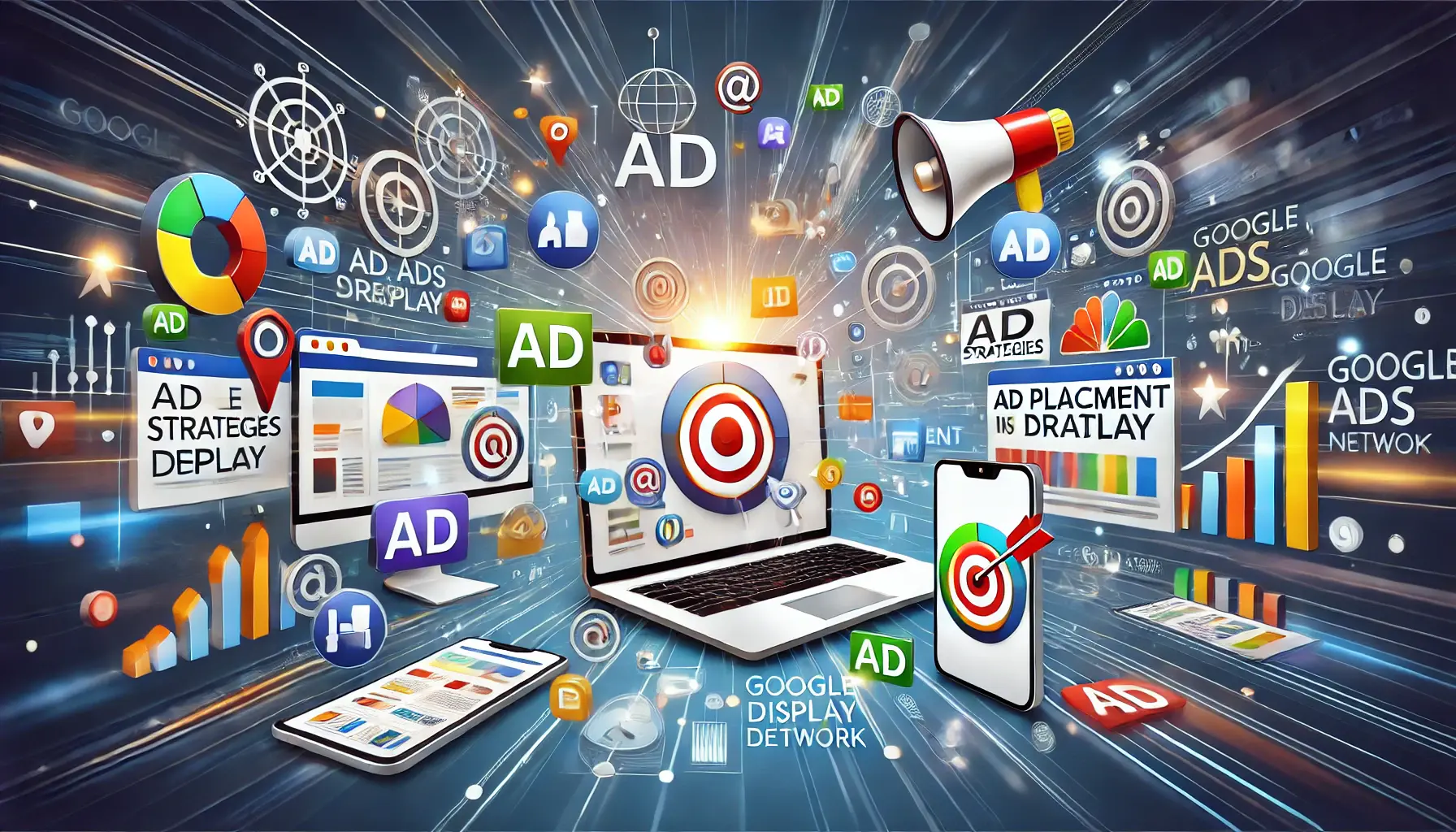In this ever-changing world of digital marketing, it’s more difficult to catch people’s attention than ever before.
Among all the ads that appear, standing out is critical, connecting with the viewers at a personal level.
This is where story adsImmersive and visually engaging advertisements designed to tell a narrative. come into play.
These innovative and creative formats will turn your Google Display Ads into powerful tools that, on top of making them visible, will nurture valuable connections with your target audience.
Story ads combine the power of storytelling with stunning visuals into one continuous storytelling experience.
Whether you aim to showcase your brand’s journey, highlight a product’s benefits, or inspire action, story ads can bridge the gap between your brand and your audience.
Let’s explore how you can effectively use story ads in your Google Display Ads campaigns, starting with understanding the concept and why they are essential in today’s competitive advertising landscape.
- What Are Story Ads and Why Use Them in Google Display Ads?
- Key Elements of a Compelling Story Ad
- Top 3 Story Ads Concepts for Google Display Ads
- Implementing Story Ads in Your Google Display Campaigns
- Measuring the Success of Your Story Ads
- Summary of Story Ads Power in Google Display Campaigns
- Google Display Campaign Story Ads: Frequently Asked Questions
What Are Story Ads and Why Use Them in Google Display Ads?
Story ads are immersive, visually-driven advertisements designed to captivate viewers by telling a compelling story.
Unlike traditional ads that focus solely on promotion, story ads aim to create an emotional connection with the audience.
These ads often utilize engaging visuals, concise text, and strategic placement to ensure maximum impact.
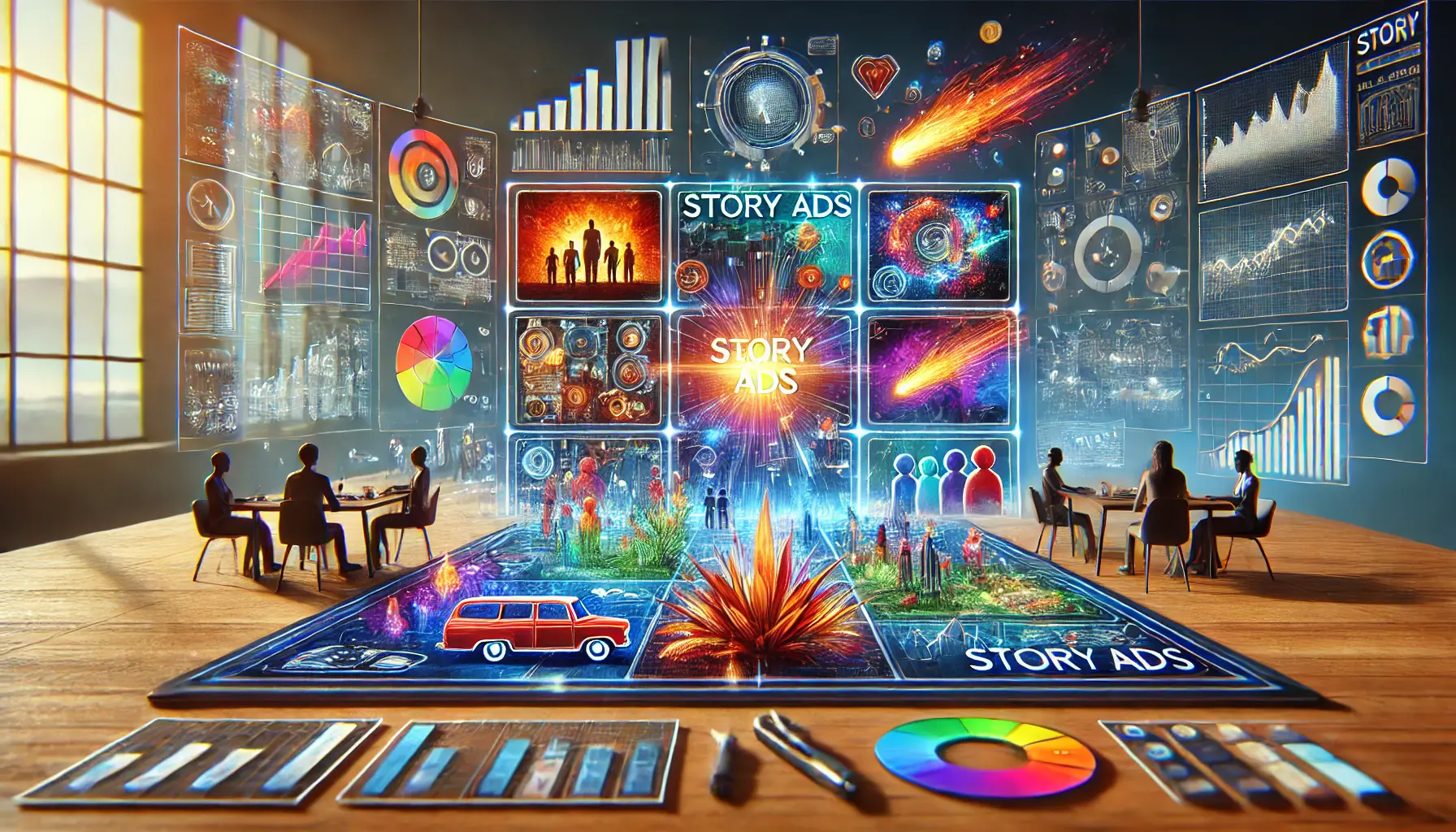
A digital representation of storytelling in advertising, illustrating the narrative process in story ads.
Understanding the Concept of Story Ads
Story ads leverage the art of storytelling to weave a narrative that resonates with the audience.
By presenting a problem, a solution, and a call-to-action in a structured format, these ads go beyond simple promotion to engage viewers on a deeper level.
For instance, instead of directly advertising a product, you can use story ads to share how the product has changed lives or solved specific challenges for customers.

Illustration of audience engagement through story ads, highlighting connection and dynamic digital storytelling.
Benefits of Story Ads for Audience Engagement
Story ads stand out because they prioritize the audience’s interests and emotions.
Here are some key benefits:
- Increased Engagement: Stories naturally capture attention and keep viewers engaged longer.
- Emotional Connection: A well-crafted story can evoke emotions, making your ad more memorable.
- Enhanced Brand Recall: When your audience connects with your story, they are more likely to remember your brand.
- Better Click-Through Rates: Story ads often lead to higher click-through rates by piquing curiosity and inspiring action.

Illustration of how story ads are integrated into Google Display campaigns, emphasizing creativity and digital connectivity.
How Story Ads Fit into Google Display Campaigns
Google Display Ads are known for their visual impact and wide reach.
Story ads fit perfectly within this ecosystem by leveraging Google’s extensive display network to deliver visually compelling narratives to your audience.
These ads can be tailored to specific demographicsStatistical characteristics of a population, such as age, gender, or income level., interests, and behaviors, ensuring your story reaches the right people at the right time.
By integrating story ads into your Google Display campaigns, you can turn passive viewers into active participants.
With a clear narrative and visually appealing design, your story ads can captivate audiences, drive traffic, and ultimately, boost conversions.
Story ads are immersive and visually driven, designed to create emotional connections and captivate audiences.
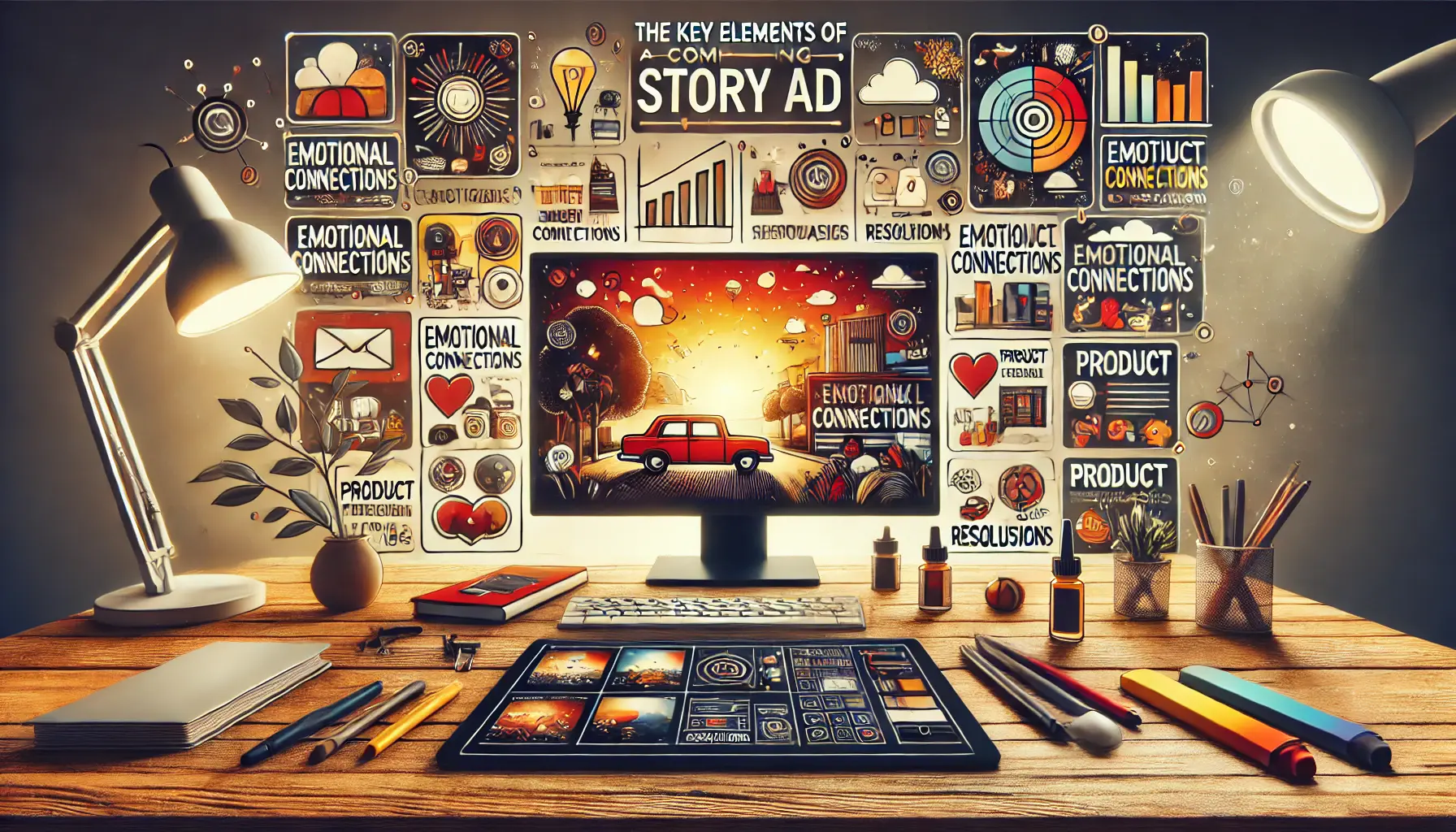
A visual representation of the key elements that make a story ad compelling, focusing on storytelling, creativity, and emotional connection.
Key Elements of a Compelling Story Ad
Creating an effective story ad for your Google Display Ads campaign involves several crucial components.
Let’s delve into these elements to understand how they contribute to crafting engaging and high-performing advertisements.

Illustration of the process of crafting an engaging narrative, highlighting the creation of compelling stories for ads.
Crafting an Engaging Narrative
At the heart of every compelling story ad is a well-structured narrative.
It should introduce relatable characters, present a problem or challenge, and demonstrate how your product or service solves it.
This storytelling approach not only captures attention but also fosters an emotional connection with your audience, making your message more memorable.
Consider these steps when crafting your narrative:
- Identify Your Audience: Understand who you’re speaking to and tailor your story to resonate with their experiences and needs.
- Define the Conflict: Clearly present a problem that your audience can relate to, setting the stage for your solution.
- Showcase the Resolution: Demonstrate how your product or service effectively addresses the problem, leading to a positive outcome.
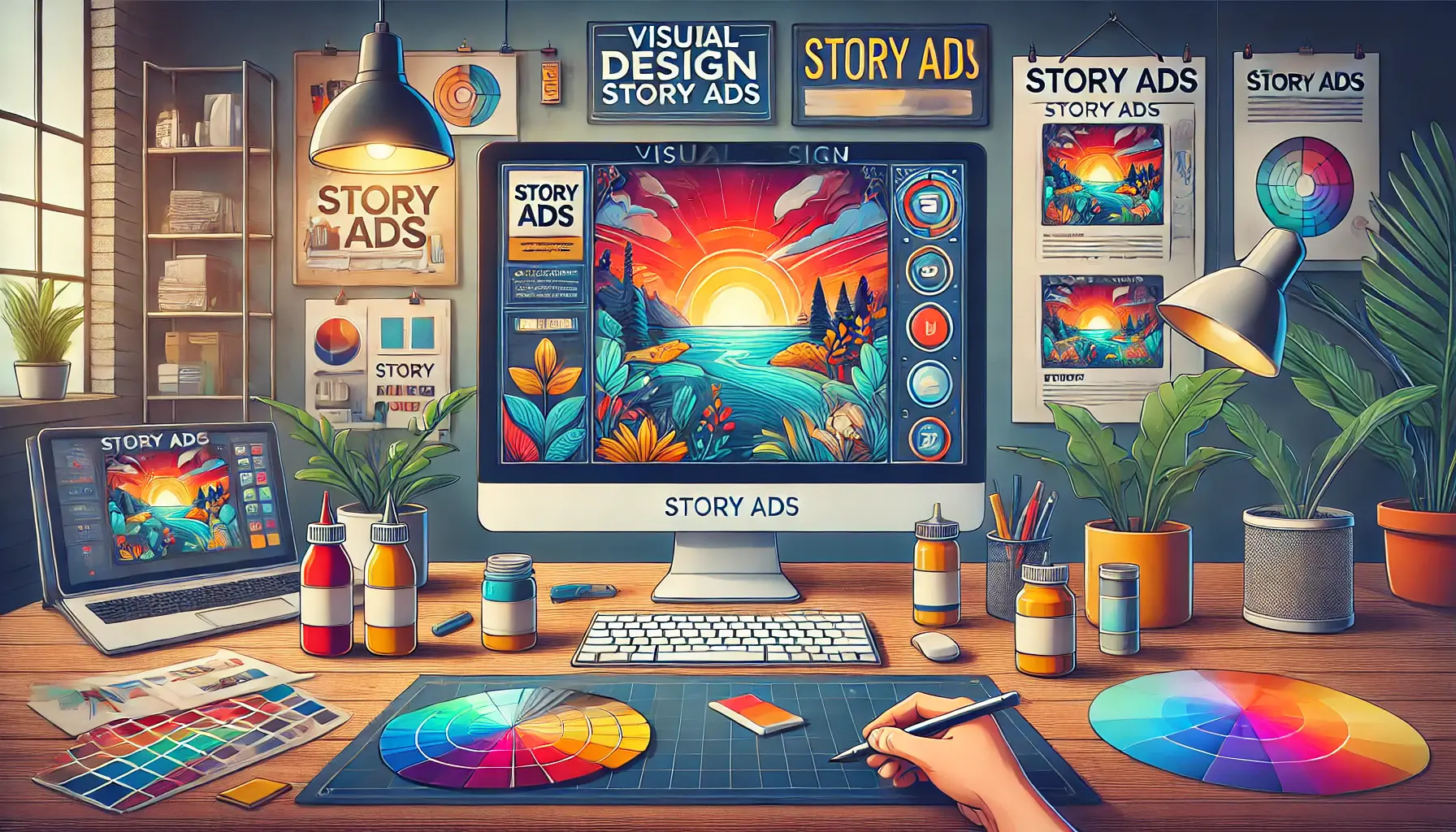
An illustration of visual design tips for story ads, showcasing cohesive color schemes, high-quality images, and modern layouts.
Visual Design Tips for Story Ads
The visual aspect of your story ad is paramount in capturing attention and conveying your message effectively.
High-quality images, cohesive color schemes, and thoughtful layouts contribute to the overall appeal of your ad.
Here are some design tips to enhance your story ads:
- Use High-Quality Images: Ensure all visuals are clear and professional to reflect the quality of your brand.
- Maintain Consistent Branding: Use colors, fonts, and logos that align with your brand identity to build recognition.
- Optimize for All Devices: Design your ads to be responsive, providing a seamless experience across various screen sizes.

Illustration of the importance of call-to-action buttons in story ads, highlighting user interaction and conversion.
The Role of Call-to-Actions in Story Ads
A clear and compelling call-to-action (CTA) is essential in guiding your audience toward the desired response.
Whether it’s visiting your website, signing up for a newsletter, or making a purchase, your CTA should be prominent and persuasive.
Consider the following when crafting your CTA:
- Be Direct and Specific: Use clear language that tells the audience exactly what to do, such as “Shop Now” or “Learn More.”
- Create a Sense of Urgency: Phrases like “Limited Time Offer” can encourage immediate action.
- Ensure Visibility: Design your CTA button to stand out, using contrasting colors and strategic placement within the ad.
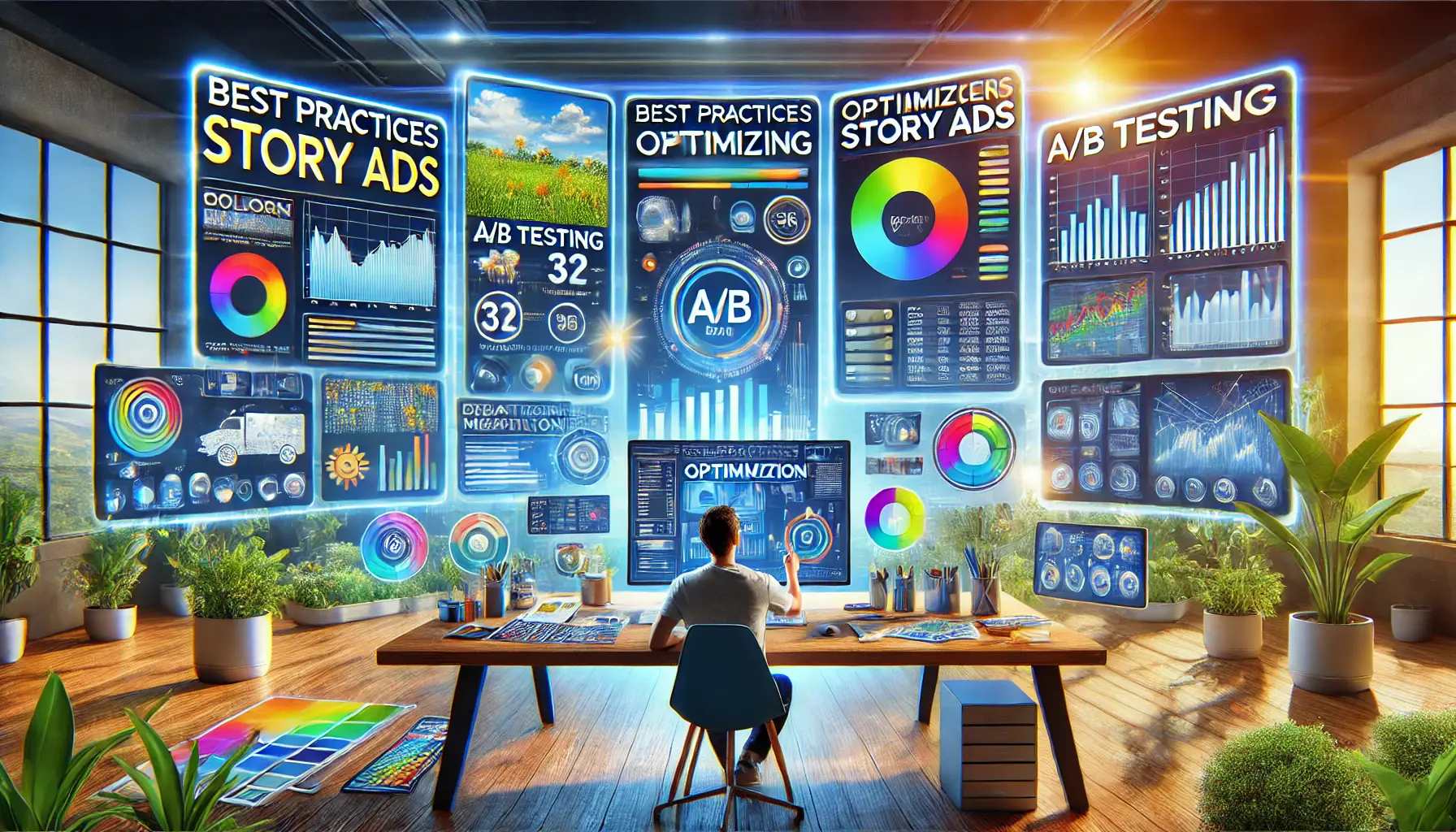
An illustration of best practices for optimizing story ads, focusing on real-time data analysis and ad performance optimization.
Best Practices for Optimizing Story Ads
To maximize the effectiveness of your story ads, it’s important to follow best practices that enhance performance and engagement.
Implement these strategies for optimal results:
- Test Multiple Variations: Create different versions of your ad to determine which resonates best with your audience.
- Monitor Performance Metrics: Keep an eye on key indicators like click-through rates and conversions to assess effectiveness.
- Refine Based on Feedback: Use insights gained from performance data to make informed adjustments and improvements.
By focusing on these key elements—crafting an engaging narrative, employing effective visual design, incorporating strong CTAs, and adhering to optimization best practices—you can create story ads that not only capture attention but also drive meaningful engagement and conversions in your Google Display Ads campaigns.
- Create relatable narratives addressing audience needs.
- Ensure visual appeal with high-quality images and cohesive branding.
- Incorporate strong and clear calls-to-action.

An illustration of the top 3 story ads concepts for Google Display Ads, highlighting different approaches to storytelling in digital marketing.
Top 3 Story Ads Concepts for Google Display Ads
Implementing innovative story ad concepts in your Google Display Ads can significantly enhance engagement and conversion rates.
Let’s explore three effective approaches to storytelling in your ad campaigns.

An illustration of immersive brand storytelling, highlighting a brand’s journey and emotional connections with the audience.
Concept 1: Immersive Brand Storytelling
Immersive brand storytelling involves creating a narrative that deeply engages your audience, allowing them to connect with your brand on a personal level.
This approach goes beyond traditional advertising by focusing on the values, mission, and journey of your brand.
To implement this concept:
- Develop a Compelling Narrative: Share the origin story of your brand, highlight key milestones, or showcase the people behind your products.
- Use Rich Media: Incorporate high-quality images, videos, and interactive elements to create a captivating experience.
- Maintain Consistency: Ensure that the story aligns with your brand identity and is consistent across all platforms.
By immersing your audience in your brand’s story, you can build a stronger emotional connection and foster brand loyalty.

An illustration of interactive story ads, showcasing user-driven elements like polls and quizzes for an engaging ad experience.
Concept 2: Interactive Story Ads
Interactive story ads engage users by allowing them to participate in the narrative.
This can lead to increased engagement and a more memorable user experience.
To build interactive story ads:
- Incorporate Interactive Elements: Include features like polls, quizzes, or hotspots that users can click on and engage with.
- Personalize the Experience: Give users choices that affect the storyline, making the ad experience more relevant and personal to them.
- Ensure Mobile Optimization: Make sure interactive elements are responsive and work well on mobile devices.
Interactive story ads make your audience feel more involved with your brand, increasing the chances of conversion.

An illustration of sequential storytelling in ads, showcasing the narrative progression from start to finish across multiple ad frames.
Concept 3: Sequential Storytelling in Ads
Sequential storytelling refers to the process of communicating an integrated story through a series of ads.
This approach can keep your audience engaged longer and guide them more effectively through the customer journey.
To implement sequential storytelling:
- Plan the Narrative Arc: Outline the beginning, middle, and end of your story, then disperse each part across different ads.
- Use Retargeting Strategies: Ensure users see the ads in the correct order with the help of retargeting techniques.
- Maintain Visual and Thematic Consistency: Apply consistent visuals and themes across all ads to reinforce the narrative.
By unfolding your story over multiple ads, you can build anticipation and deepen your audience’s engagement.
The implementation of these story ad concepts into your Google Display Ads can make your campaigns more interesting and effective.
As a result, conversion rates can increase, along with brand loyalty.
- Use immersive storytelling for deeper engagement.
- Incorporate interactive elements for participation.
- Utilize sequential ads to sustain audience interest.
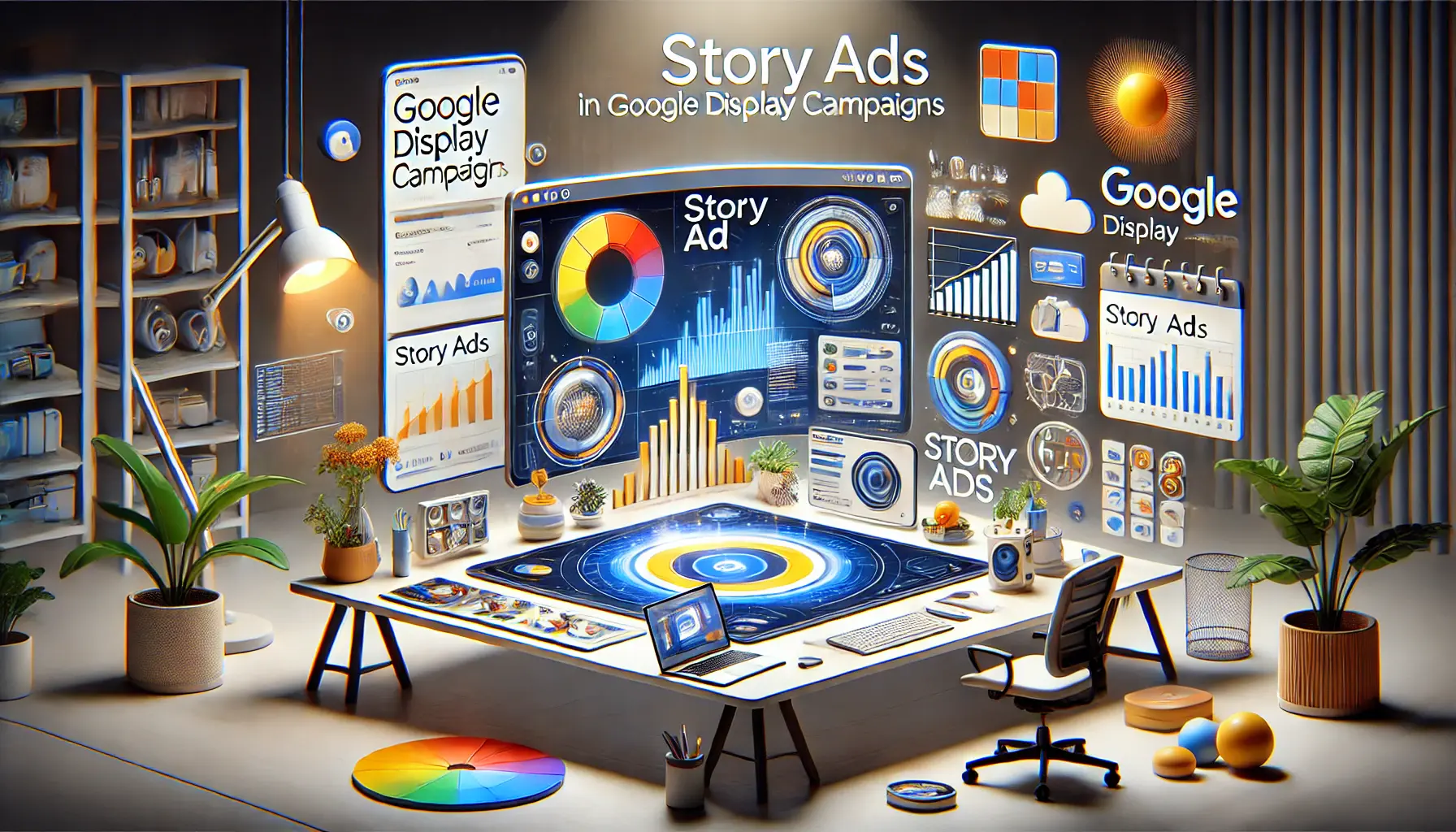
An illustration of implementing story ads in Google Display campaigns, focusing on ad setup, targeting, and optimization.
Implementing Story Ads in Your Google Display Campaigns
Integrating story ads into your Google Display campaigns can significantly enhance audience engagement and drive conversions.
Here’s how you can effectively implement story ads in your advertising strategy.

An illustration of setting up story ads in Google Display, focusing on the process of ad creation, targeting, and optimization.
Setting Up Story Ads in Google Display
To begin, create a new Display campaign in your Google Ads account.
Choose your marketing objective, such as ‘Sales’ or ‘Brand awareness,’ and select ‘Display’ as the campaign type.
Make use of responsive display adsGoogle Ads format that automatically adjusts to fit different device sizes and placements. by uploading your assets: images, headlines, logos, videos, and descriptions.
Google AI will create ad combinations optimized to perform across various platforms, including websites, apps, YouTube, and Gmail.
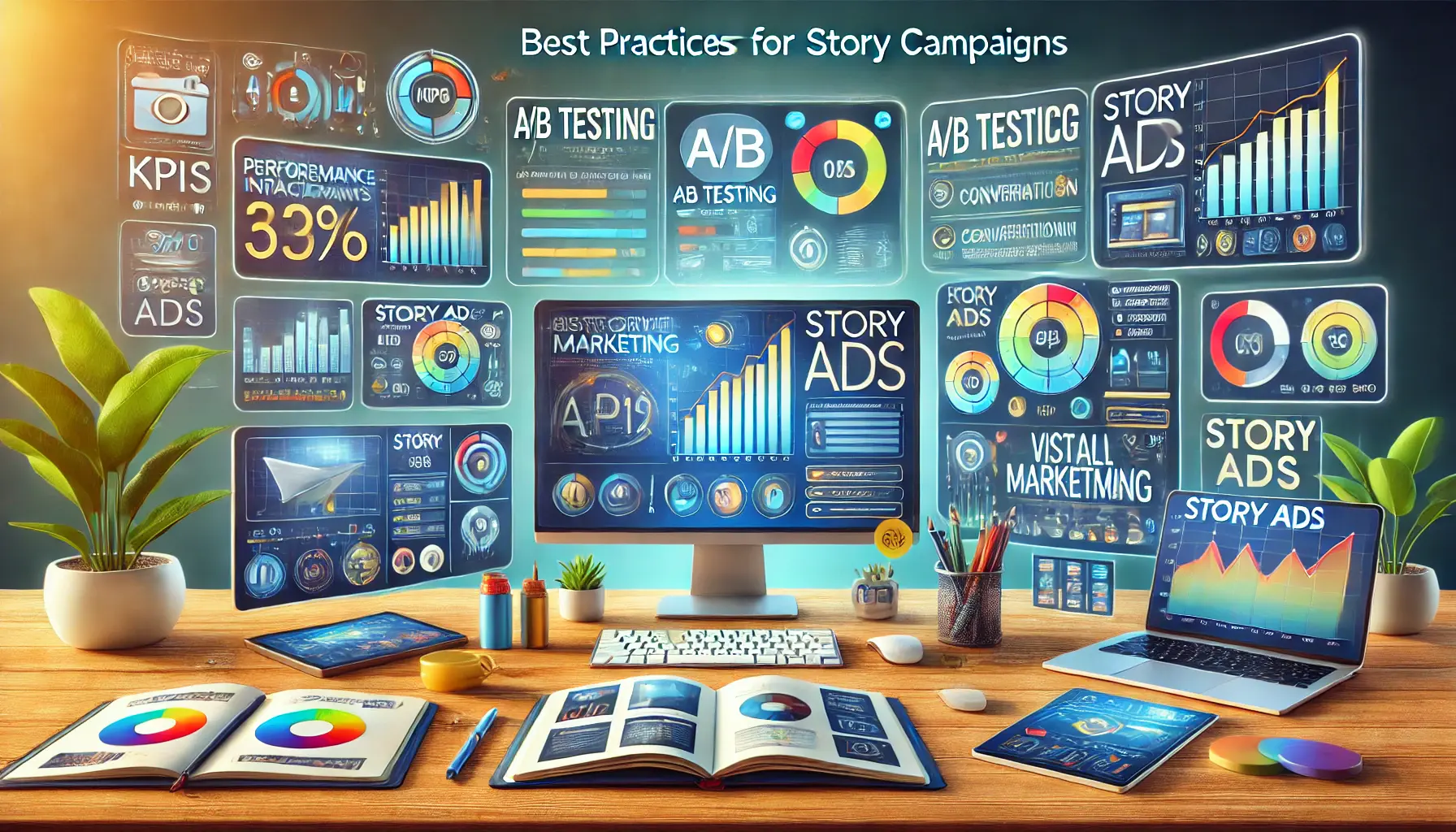
An illustration of best practices for story ad campaigns, focusing on data analysis, A/B testing, and optimization.
Best Practices for Story Ad Campaigns
To maximize the effectiveness of your story ads, consider the following best practices:
- Refresh Creative Assets Regularly: Updating your ad creatives keeps your audience engaged and allows you to promote new products or sales effectively.
- Leverage AI and Automation: Utilize AI-powered solutions to optimize ad targeting and bidding processes, enhancing campaign performance.
- Monitor Performance Metrics: Keep track of key indicators like click-through rates and conversions to assess ad effectiveness and make data-driven adjustments.

An illustration highlighting common pitfalls to avoid in digital advertising, including issues like poor mobile optimization and inconsistent branding.
Common Pitfalls to Avoid
Be mindful of the following challenges when implementing story ads:
- Overuse of AI Terminology: Consumers may be wary of AI; focus on the benefits to the human experience rather than the technology itself.
- Neglecting Mobile Optimization: Ensure your story ads are responsive and provide a seamless experience across all devices to reach a broader audience.
- Inconsistent Branding: Maintain consistent visuals and messaging across all ads to reinforce brand identity and build trust with your audience.
By following these guidelines, you can effectively implement story ads in your Google Display campaigns, creating engaging narratives that resonate with your audience and drive meaningful results.
Integrate story ads using Google’s responsive display features, ensuring consistent visuals and strategic targeting for better results.
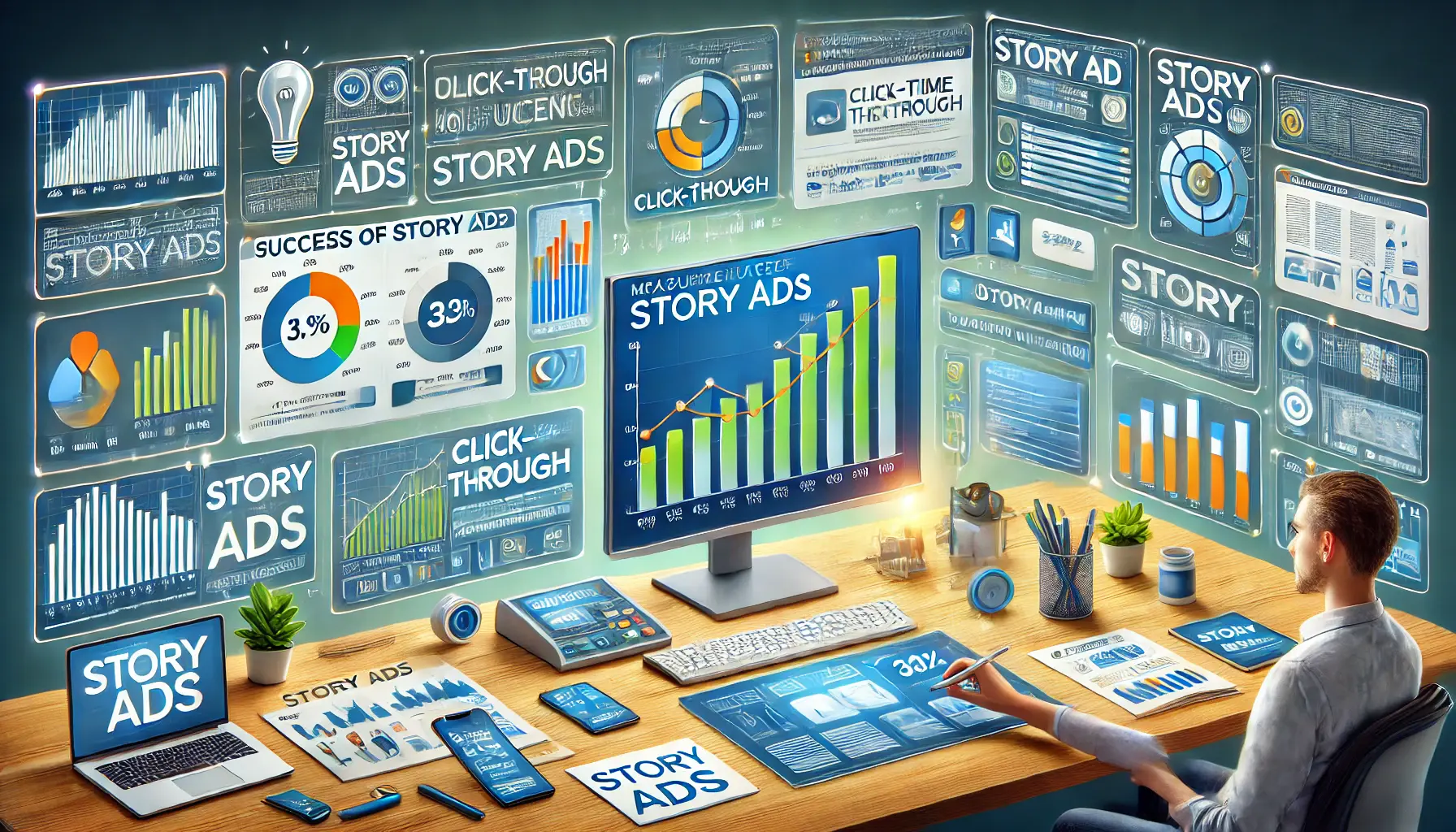
An illustration of measuring the success of story ads, focusing on tracking metrics like click-through rates, conversions, and user engagement.
Measuring the Success of Your Story Ads
Implementing story ads in your Google Display campaigns is a strategic move to enhance engagement and drive conversions.
However, to ensure their effectiveness, it’s crucial to measure their performance accurately.
Here’s how you can assess the success of your story ads.

An illustration of key performance indicators (KPIs) for story ads, focusing on ad performance and user engagement metrics.
Key Performance Indicators (KPIs) for Story Ads
Identifying the right KPIs is essential for evaluating the impact of your story ads.
Consider focusing on the following metrics:
- Click-Through Rate (CTR): Measures the percentage of viewers who clicked on your ad, indicating its appeal and relevance.
- Conversion Rate: Assesses the proportion of clicks that lead to a desired action, such as purchases or sign-ups, reflecting the ad’s effectiveness in driving outcomes.
- Engagement Metrics: Includes time spent on the landing page and interactions, providing insights into user interest and engagement levels.
- Return on Ad Spend (ROAS): Calculates the revenue generated for every dollar spent on advertising, helping determine the campaign’s profitability.
An illustration of tools for tracking and analysis in digital advertising, showcasing various analytics tools and dashboards.
Tools for Tracking and Analysis
Utilizing the right tools can streamline the tracking and analysis of your story ad performance:
- Google Analytics: Offers comprehensive data on user behavior, traffic sources, and conversion tracking, enabling in-depth analysis of ad performance.
- Google Ads Dashboard: Provides real-time metrics specific to your campaigns, including impressions, clicks, and cost analysis, facilitating immediate performance assessments.
- Heatmap Tools: Visualize user interactions on your landing pages, highlighting areas of interest and potential drop-off points, aiding in optimizing user experience.

An illustration of interpreting data to optimize future ad campaigns, focusing on performance trends, metrics, and audience insights.
Interpreting Data to Optimize Future Campaigns
Analyzing the collected data is vital for refining your advertising strategies:
- Identify Trends: Look for patterns in user engagement and conversion metrics to understand what resonates with your audience.
- A/B Testing: Experiment with different ad creatives, headlines, and calls-to-action to determine the most effective combinations.
- Adjust Targeting: Use demographic and behavioral data to refine your audience targeting, ensuring your ads reach the most receptive viewers.
- Budget Allocation: Allocate more resources to high-performing ads and consider revising or discontinuing underperforming ones to maximize ROI.
By systematically measuring and analyzing the performance of your story ads, you can make informed decisions to enhance their effectiveness, ensuring your Google Display campaigns achieve their desired objectives.
- Track metrics like CTR, conversion rates, and ROAS.
- Refine strategies using performance insights and A/B testing.
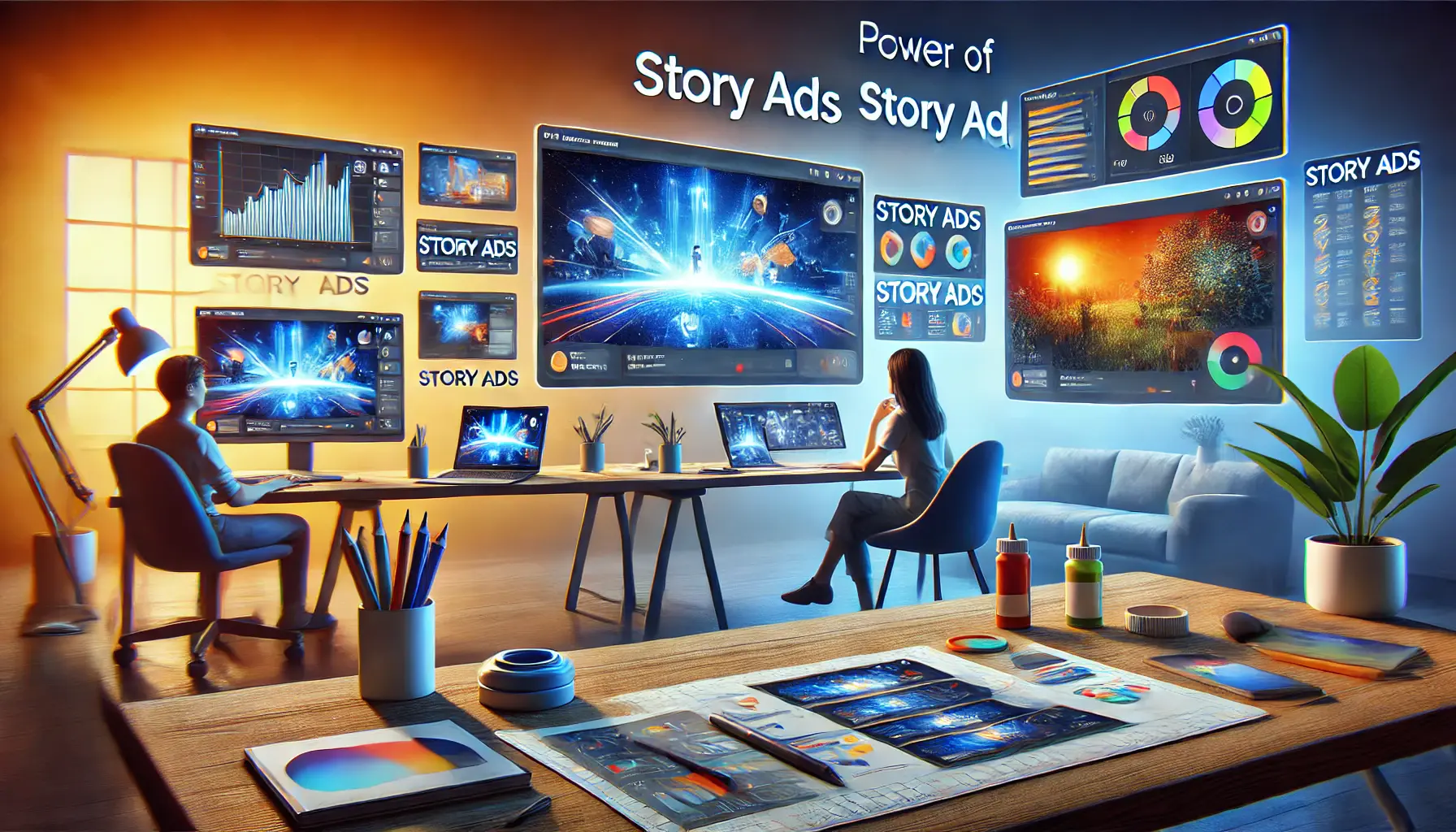
An illustration summarizing the power of story ads in Google Display campaigns, showing dynamic ads and their performance results.
Summary of Story Ads Power in Google Display Campaigns
Story ads are the game-changing way for brands to connect with their audiences.
Compelling narratives, visually stunning designs, and strategic calls-to-action work together to drive greater performance in your Google Display campaigns.
From enhancing engagement to driving conversions, these ads have the potential to create meaningful connections with your audience and achieve your marketing goals.

An illustration representing the key takeaways from the article, highlighting key story ad concepts and insights.
Key Takeaways from the Article
Throughout this article, we explored the critical components of crafting successful story ads.
Here are the key points to remember:
- The Essence of Story Ads: Story ads use engaging narratives and visuals to capture attention and foster emotional connections, making them stand out in the competitive digital marketing landscape.
- Core Elements: From crafting a relatable narrative to designing visually appealing ads and incorporating clear calls-to-action, each element plays a vital role in the success of story ads.
- Effective Concepts: Strategies like immersive brand storytelling, interactive story ads, and sequential storytelling offer diverse approaches to captivate your audience.
- Implementation Techniques: Using tools like Google Ads Manager, ensuring consistent branding, and optimizing for mobile devices can streamline the integration of story ads into your campaigns.
- Performance Measurement: Tracking metrics such as click-through rates, conversion rates, and ROAS helps assess the effectiveness of your story ads and optimize future campaigns.
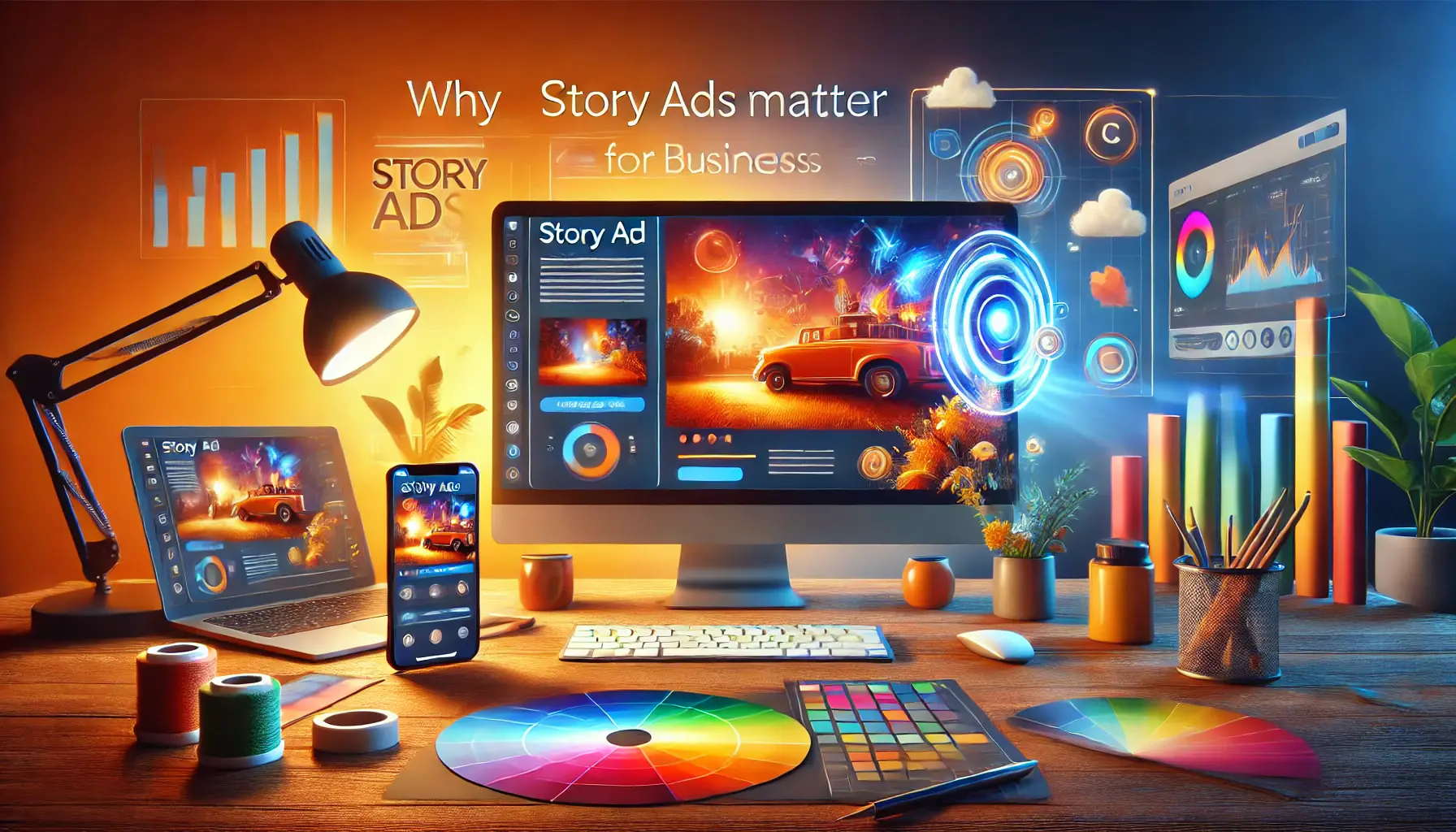
An illustration of why story ads matter for businesses, highlighting how they create an emotional connection and drive engagement.
Why Story Ads Matter for Your Business
Integrating story ads into your Google Display campaigns isn’t just about creating visually appealing ads; it’s about telling your brand’s story in a way that resonates with your audience.
This can create stronger connections, which lead to increased customer loyalty and ultimately drive business performance.
By leveraging the distinctive capabilities of story ads, businesses can establish themselves as relatable and trustworthy to their customers.
Whether you’re a small business aiming to grow or an established brand looking to maintain relevance, story ads offer a dynamic and effective solution.

An illustration of getting started with story ads, focusing on the initial steps of creating engaging ad content and setting up targeting.
Getting Started with Story Ads
If you’re ready to take your advertising strategy to the next level, start by identifying the narratives that best represent your brand.
Use the insights and strategies outlined in this article to craft and implement your story ads.
Continuously measure their performance, refine your approach, and keep your audience at the center of your efforts.
Story ads can be one of the most impactful levers in your digital marketing toolkit if planned and executed thoughtfully.
They will help you stand out and drive meaningful results in your Google Display campaigns.
Story ads leverage compelling narratives and visuals to enhance brand engagement and drive conversions.

An illustration of frequently asked questions about Google Display campaign story ads, showcasing the process of setting up and optimizing ads.
Your campaigns can be managed by an agency specialized in Google Ads, check out our service page.
Google Display Campaign Story Ads: Frequently Asked Questions
Story ads are immersive, full-screen ads tailored for the Google Display Network, designed to engage users with compelling narrative-style content.
Story ads enhance engagement, foster emotional connections, and improve brand recall, leading to higher click-through and conversion rates.
Build a strong narrative, use high-quality visuals, maintain consistent branding, and include clear calls-to-action to create an effective story ad.
Yes, story ads can be integrated into Google Display campaigns to deliver visually compelling narratives to your audience.
Content that tells a compelling story, shows your brand’s journey, highlights product benefits, or inspires action works best in story ads.
Key performance indicators to track include click-through rates, conversion rates, engagement metrics, and return on ad spend.
Yes, businesses of all sizes and industries can leverage story ads to connect with their audience and achieve marketing goals.
Story ads are supported on various platforms within the Google Display Network, including websites, apps, YouTube, and Gmail.
Refreshing your story ad content regularly helps maintain audience attention and provides opportunities to promote new products or sales.
Yes, incorporating interactive elementsFeatures like polls, quizzes, or clickable hotspots that engage users actively. like polls, quizzes, or clickable hotspots can enhance engagement in story ads.










